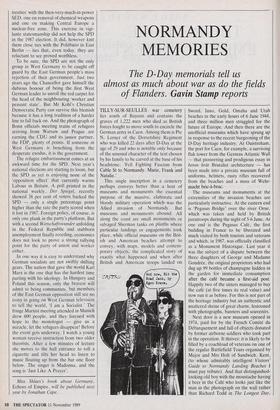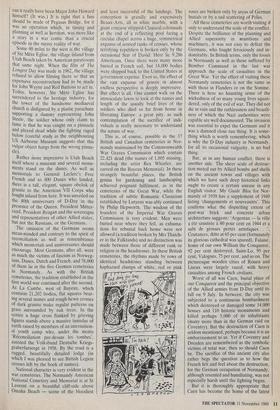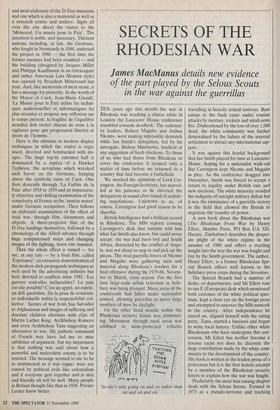NORMANDY MEMORIES
The D-Day memorials tell us almost as much about war as do the fields
TILLY-SUR-SEULLES war cemetery lies south of Bayeux and contains the graves of 1,222 men who died as British forces fought to move south to encircle the German army in Caen. Among them is Pte N. Lerner of the Dorsetshire Regiment who was killed 22 days after D-Day at the age of 29 and who is notable only because of the unusual character of the text chosen by his family to be carved at the base of his headstone: 'Fell Fighting Fascism from Cable St to Normandy. Marie, Frank and Natalie.'
This single inscription in a cemetery perhaps conveys better than a host of museums and monuments the essential purpose of the massive, elaborate and bloody military operation which was the Allied invasion of Normandy. But museums and monuments abound. All along the coast are small monuments or salvaged Sherman tanks on plinths where particular landings or engagements took place, while official museums on the Brit- ish and American beaches attempt to convey, with maps, models and contem- porary objects, the complicated story of exactly what happened and when after British and American troops landed on
Sword, Juno, Gold, Omaha and Utah beaches in the early hours of 6 June 1944, and three million men struggled for the future of Europe. And then there are the unofficial museums which have sprung up in response to the recent burgeoning of the D-Day heritage industry. At Ouistreham, the port for Caen, for example, a surviving flak tower from the German Atlantic Wall — that pioneering and prodigious essay in beton brat Brutalist architecture — has been made into a private museum full of uniforms, helmets, rusty rifles recovered from the beaches and a mass of Wehr- macht bric-a-brac.
The museums and monuments at the extremities of the invasion beaches are particularly instructive. At the eastern end is 'Pegasus Bridge' over the river Orne, which was taken and held by British paratroops during the night of 5-6 June. At one end is the Pegasus Café, the first building in France to be liberated and much visited by both tourists and veterans and which, in 1987, was officially classified as a Monument Historique. Last year it was the subject of a dispute between the three daughters of George and Madame Gondree, the original proprietors who had dug up 99 bottles of champagne hidden in the garden for immediate consumption after the cafe became a first-aid post. Happily two of the sisters managed to buy the café (at five times its real value) and now run it as before. For this is not part of the heritage industry but an authentic and unaltered shrine of great charm, festooned with photographs, banners and souvenirs, Next door is a new museum opened in 1974, paid for by the French Comite du Debarquement and full of objects donated by former airborne soldiers who took part in the operation. It thrives: it is likely to be filled by a coachload of veterans on one of the regular Battlefield Tours organised by Major and Mrs Holt of Sandwich, Kent, (to whose admirably intelligent Visitors' Guide to Normandy Landing Beaches I must pay tribute). And that distinguished- looking old boy with the moustache having a beer in the Café who looks just like the man in the photograph on the wall rather than Richard Todd in The Longest Day, can it really have been Major John Howard himself? (It was.) It is right that a fuss should be made of Pegasus Bridge, for it was an operation which, in timing and planning as well as heroism, was more like a story in a war comic than a crucial episode in the messy reality of war.
Some 60 miles to the west is the village of Ste Mere Eglise, the village inland from Utah Beach taken by American paratroops that same night. When the film of The Longest Day was made in 1962, the village refused to allow filming there so that an expensive reconstruction had to be made for John Wayne and Red Buttons to act in. Today, however, Ste Mere Eglise has surrendered to the heritage industry, for the tower of the handsome mediaeval church is disfigured by a plastic parachute supporting a dummy representing John Steele, the soldier whose only claim to fame is that he was caught on a pinnacle and played dead while the fighting raged below (careful study in the neighbouring US Airborne Museum suggests that this vulgar object hangs from the wrong pinna- cle).
Rather More impressive is Utah Beach itself where a museum and several monu- ments stand on the dunes. As well as memorials to General Leclerc's Free French and to 800 Danes who landed, there is a tall, elegant, square obelisk of granite to the American VII Corps who fought inland from here. It was unveiled on the 40th anniversary of D-Day in the presence of the Queen, President Mitter- rand, President Reagan and the sovereigns and representatives of other Allied states, but not the Russians, or the Germans.
The omission of the Germans seems mean-minded and contrary to the spirit of reconciliation as well as remembrance which memorials and anniversaries should encourage. Most Germans, after all, were as much the victims of fascism as Norweg- ians, Danes, Dutch and French, and 78,000 of them lie in the five German cemeteries in Normandy. As with the British cemeteries, the tradition established in the first world war continued after the second. At La Cambe, west of Bayeux, which contains 21,202 bodies, flat squares bear- ing several names and rough-hewn crosses of dark granite make regular patterns on grass surrounded by oak trees. In the centre a huge cross flanked by grieving figures stands above a massive tumulus of earth raised by members of an internation- al youth camp who, under the motto `Reconciliation par-dessus les tombes', assisted the Volksbund Deutsche Kriegs- graberfursorge in 1958. By the road is a rugged, beautifully detailed lodge (in which I was pleased to see British Legion crosses left by the book of names).
National character is very evident in the war cemeteries. The Normandy American National Cemetery and Memorial is at St Laurent on a beautiful cliff-side above Omaha Beach — scene of the bloodiest and least successful of the landings. The conception is grandly and expensively Beaux-Arts, all in white marble, with a giant concave stripped-Classical colonnade at the end of a reflecting pool facing a circular chapel across a huge, symmetrical expanse of serried ranks of crosses, whose terrifying repetition is broken only by the occasional Star of David. Here lie 9,286 Americans. Once there were many more buried in French soil, but 14,000 bodies were shipped back to the United States at government expense. Even so, the effect of the vast expanse of graves in almost endless perspective is deeply impressive. But effect is all. One cannot walk on the immaculate lawns to look at the names and length of the usually brief lives of the soldiers who died so far from home in liberating Europe: a great pity, as such contemplation of the sacrifice of indi- viduals is really necessary to understand the nature of war.
This is, of course, possible in the 17 British and Canadian cemeteries in Nor- mandy maintained by the Commonwealth War Graves Commission which contain 22,421 dead (the names of 1,805 missing, including the artist Rex Whistler, are carved on the Bayeux Memorial). In these strangely beautiful places, the British genius for gardening and landscaping achieved poignant fulfilment, as in the cemeteries of the Great War, while the tradition of subtle Romantic Classicism established by Lutyens was• ably continued by Philip Hepworth. The wisdom of the founders of the Imperial War Graves Commission is very evident. Men were buried near where they fell, as exhuma- tions for reburial back home were not allowed (a tradition broken by Mrs Thatch- er in the Falklands) and no distinction was made between those of different rank or religion in the headstones. In these British cemeteries, the rhythms made by rows of identical headstones standing between haphazard clumps of white, red or pink roses are broken only by areas of German burials or by a sad scattering of Poles.
All these cemeteries are worth visiting if only to understand the scale of the conflict. Despite the brilliance of the planning and Allied superiority in munitions and machinery, it was not easy to defeat the Germans, who fought ferociously and in- domitably. In British terms, only the losses in Normandy as well as those suffered by Bomber Command in the last war approach the scale of casualties in the Great War. Yet the effect of visiting these Normandy cemeteries is not the same as with those in Flanders or on the Somme. There is here no haunting sense of the wickedness of so many young lives squan- dered, only of the evil of war. They did not die in vain and the ruthlessness and beastli- ness of which the Nazi authorities were capable are well documented. The invasion was essential to expel the Germans and it was a damned close run thing. It is some- thing which is worth remembering, which is why the D-Day industry in Normandy, for all its occasional vulgarity, is no bad thing.
But, as in any human conflict, there is another side. The sheer scale of destruc- tion meted out by Allied bombs and shells on the ancient towns and villages with which we have such deep historical links ought to create a certain unease in any English visitor. My Guide Bleu for Nor- mandy of 1939 has a supplement of 1949 listing `changements et nouveautes'. This confirms what the dispiriting extent of post-war brick and concrete urban architecture suggests: `Argentan — la ville a ete sinistree a 80 pour cent en 1944 et a subi de grosses pertes artistiques . . Coutances, ditto at 65 per cent (fortunately its glorious cathedral was spared), Falaise, home of our own William the Conqueror, 92 per cent destroyed, Saint-Lo, 95 per cent, Valognes, 75 per cent, and so on. The picturesque wooden cities of Rouen and Liseux were largely razed, with heavy casualties among French civilians.
Worst of all was Caen, burial place of our Conqueror and the principal objective of the Allied armies from D-Day until its fall on 9 July. In between, the city was subjected to a continuous bombardment which destroyed or damaged some 14,000 houses and 110 historic monuments and killed perhaps 5,000 of its inhabitants (many more than in the German raid on Coventry). But the destruction of Caen is seldom mentioned, perhaps because it is an embarrassment to us. Yet if Coventry and Dresden are remembered as the symbolic victims of total war, then so should Caen he. The sacrifice of this ancient city also rather begs the question as to how the French felt and feel about the destruction, for the German occupation of Normandy, although resented and humiliating, was not especially harsh until the fighting began.
But it is thoroughly appropriate that Caen has become the home of the latest and most elaborate of the D-Day museums and one which is also a memorial as well as a research centre and archive. Signs all over the city direct the visitor to the `Memorial. Un musee pour la Paix'. The intention is noble, and necessary. Thirteen nations, including, at last, the Germans, who fought in Normandy in 1944, endorsed the project in 1986 — the first time the former enemies had been reunited — and the building (designed by Jacques Millet and Philippe Kauffmann in an extravagant and rather American Late Modern style) was opened by President Mitterrand last year. And, like memorials of mere stone, it has a message for posterity. In the words of the Mayor of Caen, Jean-Marie Girault, `Le Musee pour la Paix utilise les techni- ques audiovisuelles et informatiques les plus recentes et propose une reflexion sur le temps present: la fragilite de requilibre mondial doit inciter chacun de nous a la vigilance pour que progressent libertes et droits de l'homme.'
Here is the ultimate in modern display techniques in which the visitor is orga- nised, directed and bombarded with im- ages. The huge top-lit entrance hall is dominated by a replica of a Hawker Typhoon, the aeroplane which wreaked such havoc on the Germans, hanging above the symbolic ruins of Caen. One then descends through 'La Faillite de la Paix' after 1918 to 1939 and an impressive- ly objective and chilling examination of the complexity of France in the `annees noires' under German occupation. Then follows an elaborate examination of the effect of total war, through film, documents and objects. A three-projector film of the D-Day landings themselves, followed by a chronology of the Allied advance through huge computerised maps and changing images of the fighting, leave one stunned.
Then the whole effect is ruined — for me, at any rate — by a final film, called Esperance': an extensive demonstration of the modern slick propaganda techniques so well used by the advertising industry but here devoted to conflicts since 1945. 'Les guerres sont-elles ineluctables? La paix est-elle possible? C'est un appel, un espoir, un defi quotidien. De la prise de conscien- ce individuelle naitra la responsibilite col- lective.' Scenes of war from San Salvador to Afghanistan and images of suffering and desolate children alternate with clips of Martin Luther King, Archbishop Romero and even Archbishop Tutu suggesting an alternative to war. My pathetic command of French may have led me to miss subtleties of argument, but my impression is that nothing was said about how a powerful and malevolent enemy is to be resisted. The message seemed to me to be as sentimental as it was vague: wars are caused by political evils like colonialism and if everyone gets together and is nice and friendly all will be well. Many people in Britain thought like that in 1938. Private Lerner knew better.












































































 Previous page
Previous page